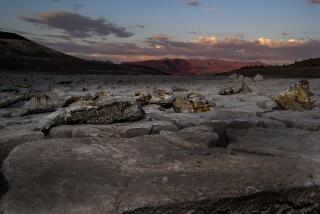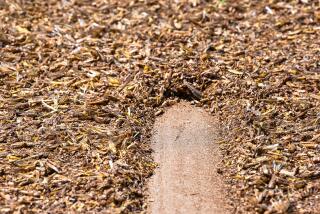Grazing on federal land under threat because of drought
- Share via
Reporting from Snake River Plain, Idaho — There’s not much anyone can tell Barry Sorensen about Idaho’s Big Desert that he doesn’t know. Sorensen, 72, and his brother have been running cattle in this sere landscape all their lives, and they’ve weathered every calamity man and nature have thrown at them — until this drought came along.
Sitting recently in a rustic cabin where he spends many months looking after his cattle, Sorensen’s voice was tinged with defeat.
“To be honest with you,” he said, “I think our way of life is pretty much going to be over in 10 years.”
Years-long drought has pummeled millions of acres of federal rangeland in the West into dust, leaving a devastating swath from the Rockies to the Pacific.
Add to that climate change, invasive plants and wildfire seasons that are longer and more severe, and conditions have reached a breaking point in many Western regions. The land can no longer support both livestock and wildlife.
“All these issues — it’s changing the landscape of the West, dramatically,” said Ken Wixom, who grazes 4,000 ewes and lambs on BLM land in the Snake River Plain. For public lands ranchers like him who depend on federal acreage to sustain their animals, the mood ranges from brooding to surrender.
The situation was spelled out in stark terms in two recent letters from the federal Bureau of Land Management. They told the ranchers what they already knew: Unless something changes, the days of business as usual on the 154 million acres of federal grazing land are over.
This drought-stressed range in Idaho can no longer sustain livestock, the letter warned. Better plan to reduce herd numbers by at least 30% for the spring turnout.
“I knew it was coming,” said Sorensen, squinting as the afternoon sun poured through a window.
Sorensen’s grazing allotment is so compromised that he was forced to make multiple adjustments. He waited 2 1/2 weeks longer than usual before turning out his cows and calves on BLM pastures, and then released only half his herd. The rest he kept on his ranch, feeding them hay from his own fields.
Conditions could easily grow worse.
Livestock shares the range with wildlife, including the greater sage grouse, a species dependent on sagebrush and native grasslands to survive. The grouse population has plummeted by 93% in the last 50 years, and its habitat has shrunk to one-quarter of its former 240,000-square-mile range.
If the federal government grants endangered species protection to the grouse sometime next year, ranching on federal land will be cut back even more, federal officials say. In some regions, public lands ranching might end altogether.
The problem for livestock and wildlife alike is that the drought has been merciless on all plants in the West. Last week 60% of the 11 Western states were experiencing some degree of serious drought.
Climate change has altered weather patterns so much that vegetation in some regions is transforming from abundant sagebrush, grass and forbs to a new landscape of weeds and cheat grass — fast-burning fuels that propel wildfire and destroy rangeland.
In southern New Mexico, the transformation has gone one step further — from sagebrush to weeds to sand-blown desert — and biologists say the pattern is likely to be repeated across the West.
If that happens, the economics of cattle ranching will unravel.
Public lands grazing is a remnant of Washington’s interest in settling the West by providing a financial leg up to covered-wagon pioneers and private interests alike. Ranchers pay a fee, far below market rate, for each mother cow and calf they turn out to graze on BLM acreage.
If public land is not available, ranchers could find private property to graze their animals, paying as much as 16 times more than on federal ground. They could reduce their herds, losing valuable genetics and other breeding characteristics and getting perhaps $1,000 for a cow that would cost $1,600 to replace.
Ranchers could bring the cattle to their own land and feed them with hay or alfalfa they grow or buy. None of that is consistent with the business model of a public lands rancher.
“You buy hay at $200 a ton, so you feed one ton for each 100 head of cows,” said Sorensen. “If you’ve got 200 head of cows, you are feeding $400 to $500 dollars’ worth of hay a day.”
Critics of ranching on federal land have little sympathy. They say the operations are highly subsidized by taxpayers and are secondary to the goal of preserving wildlife and native ecosystems.
Grazing receipts in fiscal year 2013 were $12.2 million, while the program cost the government $48.2 million to operate. Fees are based on range conditions that existed in 1966, and the monthly charge of $1.35 for a cow and calf hasn’t significantly changed in 50 years. Sporadic attempts to raise fees have been fiercely and immediately quashed.
Ranchers argue that they are excellent stewards of the land and that they make improvements that benefit deer, birds and other wildlife as well as improve water quality.
“Without ranchers functioning, the landscape ceases to function,” said rancher Shane Rosenkrance, 52, who grazes on 110,000 acres of BLM and state land in eastern Idaho.
Equally persuasive arguments are made by biologists and conservation groups. They say historic overgrazing caused wholesale changes to the landscape and fostered the damaging growth of cheat grass — which has fanned wildfires in the West.
And, they say, when ranchers allow cattle to trample streams and riverbeds, especially in a drought, crucial riparian areas can be destroyed.
The sage grouse is particularly vulnerable to sagebrush loss. Cattle grazing reduces forbs and grasses the birds use for protection and cover, leaving them exposed to predators.
Alarmed Western state governors, fearful that an endangered species listing could also mean the end of energy, mining and other commercial activities on federal land, are scrambling to protect the birds and their breeding grounds.
Kurt Wiedenmann, a BLM manager in Boise, said the drought and the sage grouse have federal and state agencies working together to find room for both grazing and the imperiled birds. Ranchers have already been hit hard by grazing cutbacks, Wiedenmann said, noting that many of them are small-scale, not corporate operations.
Leo Drozdoff, director of Nevada’s Department of Conservation and Natural Resources, said federal land managers need to take stronger action to preserve sage grouse populations before they reach endangered levels.
“I don’t think there’s any doubt that overgrazing and some older grazing practices have not been helpful,” Drozdoff said. “But this has been happening over decades, and for a variety of reasons. That should be an indication that the status quo isn’t good enough.”
Ranchers have responded by opposing efforts to list the grouse as endangered. This spring, Wixom, the sheep rancher, met with officials in Washington, D.C., to discuss the sage grouse. His advice to fellow ranchers is to stop complaining and start fighting.
“If you are in a fistfight, the last thing you want to do is start crying,” Wixom said, leaning against the cab of his pickup. “If we come out here and say, “We’re doomed,’ they are just going to hit you harder.”
Some environmental groups, such as Idaho-based Western Watersheds Project, can’t envision any science-based plan to preserve sage grouse habitat that would allow sheep and cattle grazing.
“If land management agencies truly take science into account, the Forest Service and the BLM will have to greatly reduce grazing in ways we haven’t seen before,” said Travis Bruner, the organization’s executive director. “A lot of ranchers will probably see it as a game changer.”
Sorensen does. “I think it’s inevitable” that the sage grouse will eventually push cattle off the range, he said.
When that happens, it will trigger a cascade of ruinous changes to an ecosystem that has adapted to livestock, he said.
“All of this ground is going to go to hell. There won’t be any cattle to eat the grass. That grass will burn. Then there will be no sage grouse left.”
Twitter: @Julie_cart
More to Read
Sign up for Essential California
The most important California stories and recommendations in your inbox every morning.
You may occasionally receive promotional content from the Los Angeles Times.











